After the decline of the Mauryan Empire in the second century BC, various rulers controlled the regions which were once under the Mauryas, like the Shungas, Kanvas, Kushanas and Guptas in the north and central India; and the Satavahanas, Abhiras, Ikshvakus and Vakatakas in the south and western India. This period also saw the emergence of Brahmanical sects like the Shaivas and the Vaishnavas. India after the Mauryas was not a particularly remarkable time in terms of political unity, but it did see a significant development of Indian art and culture.
Examples of fine sculpture are found at:-
Bharhut and Vidisha (Madhya Pradesh); Mathura (Uttar Pradesh); Bodhgaya (Bihar); Jaggayyapeta (Andhra Pradesh); Bhaja and Pavani (Maharashtra); and Khandagiri and Udaigiri (Odisha).
Post Mauryan Art & Architecture:
Bharhut:
- Bharhut stupas are towering, like the Mauryan depictions of Yaksha and Yakshini.
- The sculptural volume is modeled in low relief to ensure linearity.
- Narratives depict relief panels, and selecting major events improves the clarity of the narratives.
- Narrative panels begin with fewer characters, but as time goes on, others, in addition to the main character in the story, have begun to appear in the picture space.
- At Bharhut, narrative reliefs demonstrate how artists effectively communicated stories using pictorial language.
- One such story is Queen Mahamaya/(Siddhartha Mayadevi’s Gautama’s mother) dream.
- The queen is reclining on the bed, with an elephant on the top of the bed moving towards Mayadevi’s womb.
- The portrayal of a Jataka story, on the other hand, is quite basic – it is recounted by grouping events according to the geographical area of the story, such as the Ruru Jataka picture, which shows a Bodhisattva deer rescuing a man on his back.
- Such Jataka stories were used to decorate stupas.
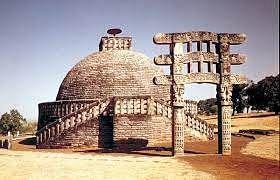
Sanchi:
- In terms of stylistic advancement, the next phase of cultural growth at Sanchi stupa-1, Mathura, and Vengi in Andhra Pradesh is remarkable.
- Sanchi’s Stupa-1 contains both an upper and lower pradakshina patha or circumambulatory walk.
- The sculptures on the entrances of Stupa-1 make it the best example of stupa building (torans).
- It began as a tiny brick structure that grew over time and was eventually covered in stone, vedika (fence), and torans.
- It includes four ornately decorated Torans (Gateways) portraying scenes from Buddha’s life and Jataka stories.
- Figure compositions have a lot of relief and take up a lot of room.
- The stance is depicted in a naturalistic manner, with no stiffness in the body.
- The story becomes more detailed, and the carving methods appear to be more sophisticated than Barhut’s.
- Symbols continued to depict Buddhas or Buddhas from the past (according to the textual tradition there are 24 Buddhas, but only the first one, Dipankar, and the last six are pictorially represented).
- Despite the fact that the narrative becomes more complex, the portrayal of the dream episodes stays simple (the dream of queen Mayadevi).
- Stupa-2 houses the relics of ten lesser-known Arhats from three generations. (An Arhat is a perfected person who has gained Nirvana in Theravada Buddhism.)
- In some Buddhist traditions, the phrase refers to persons who have made significant progress on the path to Enlightenment but have not yet attained full Buddhishood.
- The relics of Sariputta and Mahamoggallana/Mahamouglayan can be found in Stupa-3 (disciples of Gautama Buddha).
- The top pradakshina patha is likewise peculiar to this location (i.e., totally two pradakshina patha).
- The four doorways are adorned with statues in abundance.
- An empty throne, feet, chhatra, stupas, and other symbols are used to represent Buddha.
- Torans can be built in any of the four directions.
- Despite the fact that stupa-1 is the earliest stupa, the carvings on stupa-2’s vedika are older than those on stupa-1.
- The Jataka stories became an important component of the stories as well.
- Sanchi’s figures, despite their small size, are extremely realistic.
- On sculptors, there are guardian images, and salabhanjika sculptures are notable for their quantity (salabhanjika sculptures are sculptures of ladies holding a branch of a tree/plate, etc.).
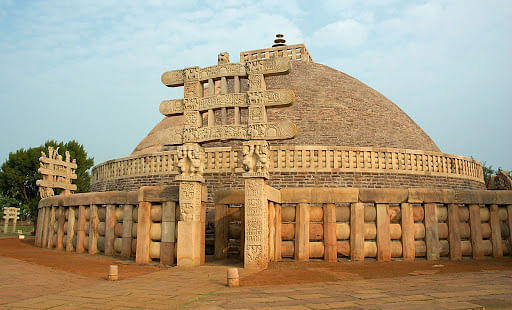
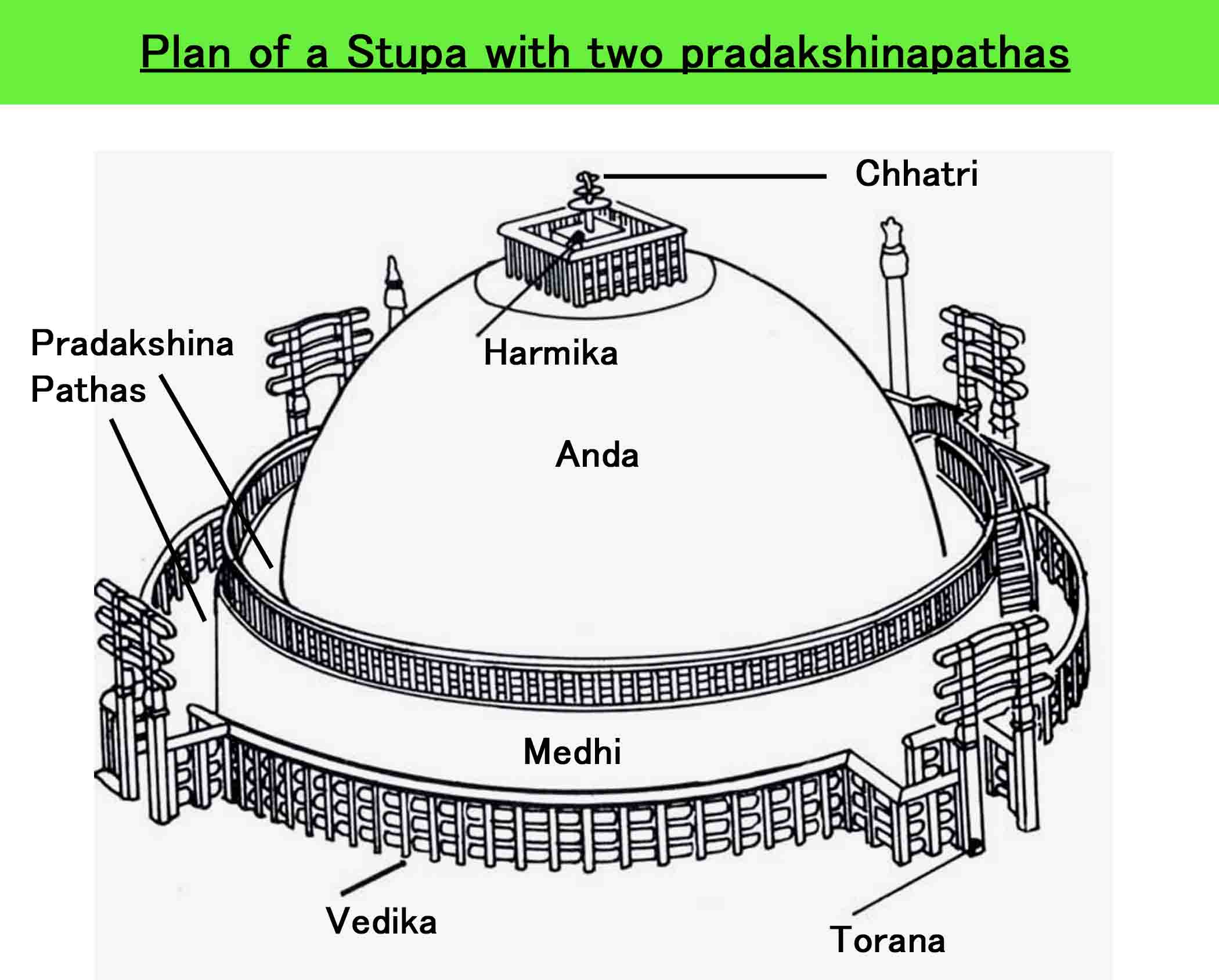
Sculpture:
Post Mauryan empire three prominent schools of the sculpture came into prominence in three different regions of India namely Gandhara, Mathura, and Amravati schools.
Gandhara:
The Gandhara School of Art or Greco-Indian School of Art (First sculptural representation of Buddha in human form) has its origin in Greco tradition (Greek invaders brought with them the traditions of the Greek and Roman sculptors) which was further merged with the regional or local art of the time.
- Initial Development: Gandhara school was developed in the western frontiers of Punjab.
- Patronage: This school was patronized by both Shaka and Kushan rulers.
- Key Features: Buddha was depicted in Gandhara Art, through four types of hand gestures called Mudras:
- Abahayamudra: Indicates fearlessness
- Dhyana mudra: Indicates meditative position
- Dharmachakramudra: Means turning the wheel of law.
- Bhumisparshamudra: Touching the earth with right hand and calling it to witness truth.
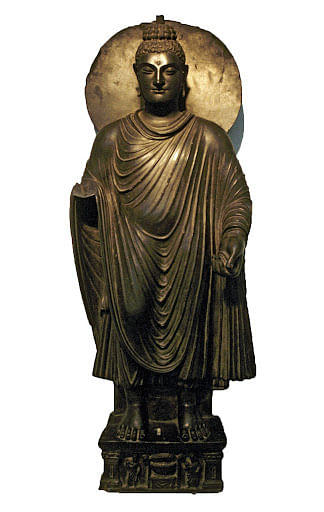
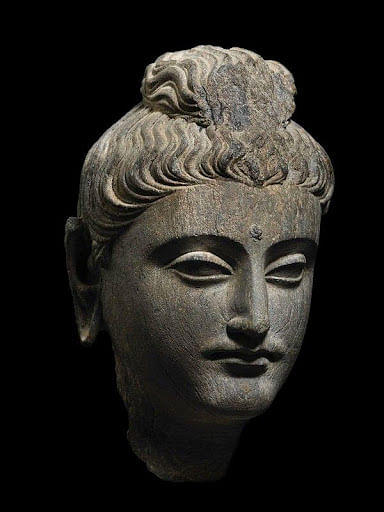
Mathura:
The Mathura art tradition became so strong that it spread to other parts of northern India.
-
-
- Best example: Stupa sculpture at Sanghol, Punjab.
- The Buddha images in the Mathura school are modelled on the earlier Yaksha images.
- Mathura art form also has some images of the Shaiva and Vaishnava faiths but images of the Buddha are numerous.
- There is less symbolism here as compared to the Gandhara School.
- The sculptures are generally made of red sandstone.
- The garments are clearly visible and they usually cover the left shoulder. Multiple folds are shown.
- The halo around the deity is profusely decorated.
- In the 2nd century, the images get fleshier and their rotundity increase.
- In the 3rd century, the fleshiness is reduced. Movement is shown by increasing the distance between the legs and bending of the body. There is more softness in the surface.
- But in the late 4th century, this trend is reversed and the flesh becomes tightened.
- In the 5th and 6th centuries, the drapery is integrated into the mass.
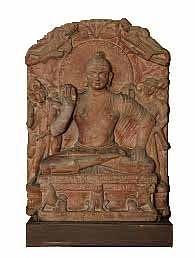
-
Amaravati:
Gandhara and Mathura schools which focused on single images, Amaravati school laid more emphasis on the use of dynamic images or narrative art (like jataka tales).
- Initial Development: Amaravati school was developed on the banks of the Krishna river.
- Major Centres: Amaravati and Nagarjunakonda.
- Patronage: This school was patronized by Satvahana rulers.
- Key Feature: Tribhanga posture, i.e. the body with three bends was used excessively by Amaravati school in its sculptures.
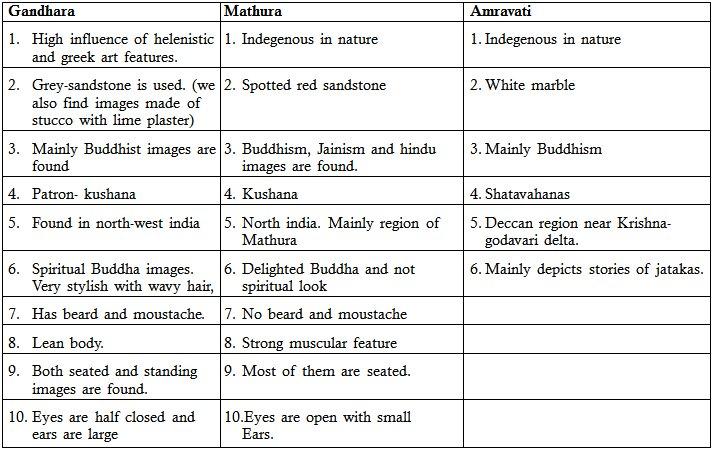
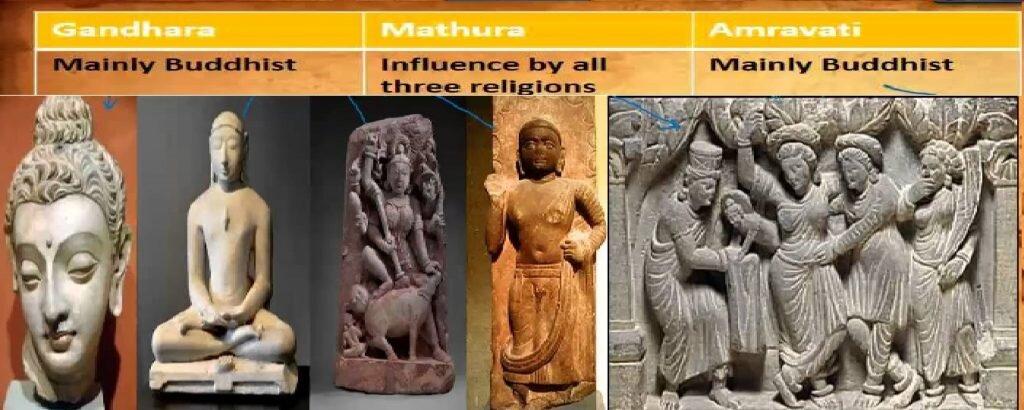
Seated Buddha at Sarnath:
- The late fifth-century CE figure of Buddha from Sarnath is fashioned of chunar sandstone.
- Padmasana depicts the Buddha seated on a throne.
- Sarnath’s seated Buddha image
- As the figures on the throne show, it signifies Dharmachakrapravartana (first sermon).
- A Chakra (wheel) is depicted in the centre of the panel below the throne, with a deer on either side and his students.
- As a result, it is a portrayal of the historic occurrence of Dharmachakrapravartana, or dhamma preaching.
- It is the best example of sculpture from the Sarnath School.
- In comparison to earlier images from the Kushana period at Mathura, the face is round, the eyes are half closed, the lower lip protrudes, and the roundness of the cheeks has decreased.
- Dhamma Chakra Pravartana Mudra is presented on the hands.
- The hair on the Ushnisha is curled in a round pattern.
- The goal of ancient Indian sculptures was to depict the Buddha as a wonderful human being who had attained Nibbana (cessation of anger and hate).
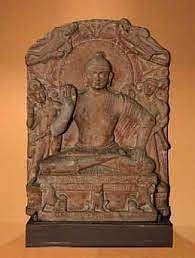
Cave tradition in western India:
- Many Buddhist caves dating back to the second century BCE have been discovered in western India.
- Chaitya hall with the apsidal vaulted roof (found at Ajanta, Pitalkhora, Bhaja)
- Apsidal vaulted vaulted vaulted vaulted vaulted vaulted vaulted vaulted vaulted vaulted vault (found at Thana-Nadsur)
- A quadrangular hall with a circular chamber at the back and a flat roof (found at Kondivite)
- A stupa is found in the back of all chaitya caves.
- Karla, Maharashtra, has the world’s largest rock-cut chaitya hall.
- Viharas have been discovered in all of the caverns.
- The vihara’s layout consists of a veranda, a hall, and cells surrounding the hall’s walls.
- Interior decorative themes such as chaitya arches and vedika decorations over the cave’s cell entrances can be found in many early vihara caves.
- Later on, a stupa was erected to the back of the vihara, and it was renamed Chaitya-Vihara.
- Junnar (Maharashtra) has the most cave excavations, with more than 200 caves around the town’s hills, whereas Kanheri (Mumbai) has 138 caves explored.
Ajanta:
-
- The famous cave site in western India is Ajanta.
- It is located in Aurangabad district of Maharashtra.
- It has 29 caves, including 4 chaitya caves.
- It has the large Chaitya-Vihara and is decorated with sculpture and paintings (murals).
- Ajanta is the only surviving example of the painting of the first century BCE and the fifth century BCE.
- Some of the vihara caves here are unfinished.
- The important patrons of Ajanta were Varahadeva, the Prime Minister of Vakataka king Harisena; Upendragupta, the local king of the region and feudatory of Harisena; Buddhabadra and Mathurasena.
- Major paintings are in cave Nos. 1, 2, 16 and 17.
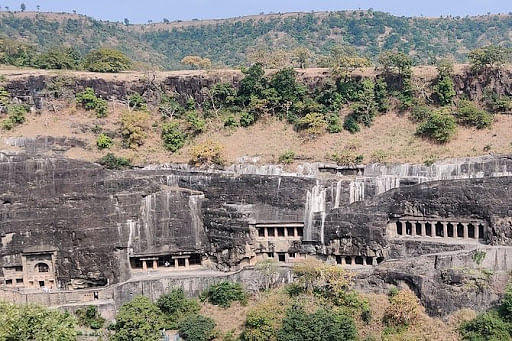
MARA VIJAYA, AJANTA CAVE NO. 26:
-
-
- The theme of Mara Vijaya has been painted in the caves of Ajanta, but only cave no.26 has a sculptural representation, sculpted on the right wall.
- The panel shows the image of the Buddha in the centre, surrounded by Mara’s army.
- The event is the part of enlightenment and Mara represents desire.
- It is the personification of mind which the Buddha went through at the time of enlightenment.
- The Buddha is shown with his right hand indicating towards the earth as a witness to his generosity.
- The image of Mara is shown contemplating how to disturb Siddhartha, the name of Buddha before enlightenment.
-
Ellora:
-
-
-
- Another important cave site located in Aurangabad is Ellora.
- It is located 100kms away from Ajanta.
- There are 32 Buddhist, Brahamanical and Jain caves.
- It is unique art historic site in the country as it has monasteries associated with the three religions dating from fifth century CE onwards to eleventh century CE.
- It is also unique in terms of stylistic eclecticism, i.e., the confluence of many styles at one place.
- There are 12 Buddhist caves having many images belonging to Vajrayana Buddhism.
- Buddhist caves are big in size and are of a single, double and triple storey.
- The triple storey of Ellora is a unique one.
- Pillar designs grow from Buddhist caves and when they reach Jain caves (9th century CE), they become very ornate and the decorative forms gain heavy protrusion.
- Most of the caves of Brahamanical faith are dedicated to Shaivism.
- The different avatars of Vishnu are also depicted here.
- Cave no.16 is known as Kailas Leni/ kailasa temple.
- It is a rock cut temple which is carved out of a single rock.
- It was built in the 8th century CE.
- The grand sculpture of Ravana attempting to lift Mount Kailash, with his full might is a landmark in Indian art.
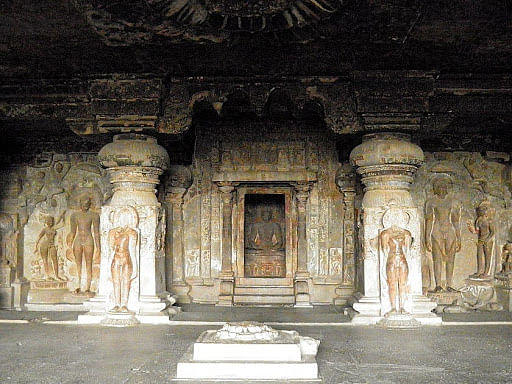
-
-
Elephanta caves and other sites:
-
-
-
-
- Elephanta caves located on Elephanta Island near Mumbai were originally a Buddhist site which was later dominated by the shaivite faith.
- It is contemporary with Ellora.
- The other noteworthy cave site is Bagh located near Indore, MP.
- The Bagh cave also contains paintings and a painting which represents a group of dancers resembles the Garba Dance of North India (originated in Gujarat).
- The tradition of rock-cut cave continued in the Deccan and they are found not only in Maharashtra but also in Karnataka, mainly at Badami and Aihole, executed under the patronage of the Chalukyas; in Andhra Pradesh in the area of Vijayawada; and in Tamil Nadu, mainly at Mahabalipuram, under the patronage of the Pallavas.
- When the early history of the country depends on collective public patronage, the post sixth century CE depends more on political patronage.
- The sculpture of Maheshmurti (Shiva at centre and heads of Bhairava and Uma on either side) is located here.
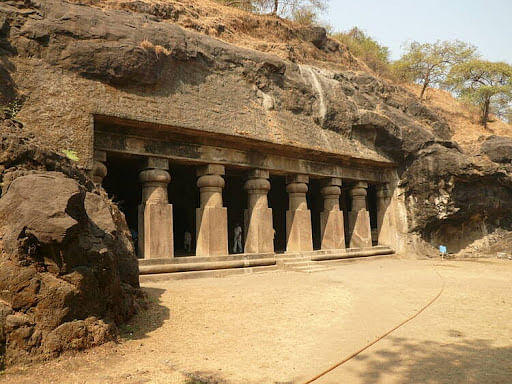
-
-
-
Cave tradition in Eastern India:
- Buddhist caves have been discovered in eastern India, primarily in the coastal districts of Andhra Pradesh and Odisha, similar to those found in western India.
- Guntapalle in the Eluru district is one of the most important places in Andhra Pradesh.
- Guntapalle is one of the few locations where structural stupas, viharas, and caverns have all been unearthed in one location.
- Rampa Yerrampalem, in addition to Guntapalle, is an important location.
- A massive rock-cut stupa was carved out of the hillock in Anakapalli, near Visakhapatnam, during the 4th-5th century CE.
- It is a remarkable location since it contains the country’s largest rock-cut stupas.
- The Udayagiri-Khandagiri caves in Odisha are another notable cave location.
- These caverns are distributed around the area and contain inscriptions from the Kaharvela Kings.
- The caves were intended for Jain monks, according to the inscription.
- Numerous single-cell excavations can be seen here.
- The upper half of the cell is embellished with a succession of Chaitya arches and legends that are still told in the region’s folklore.

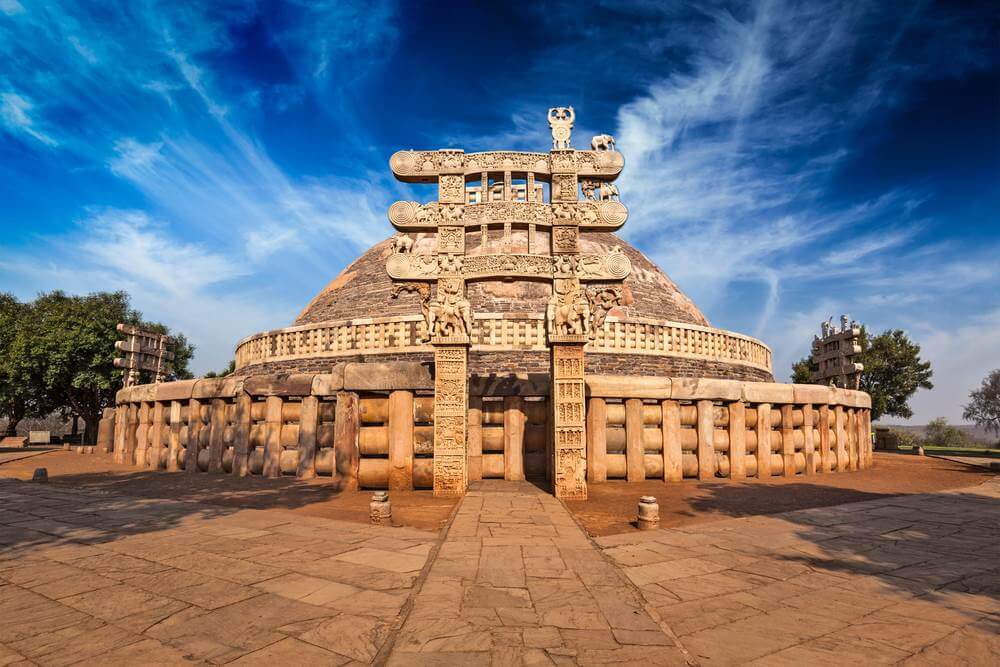
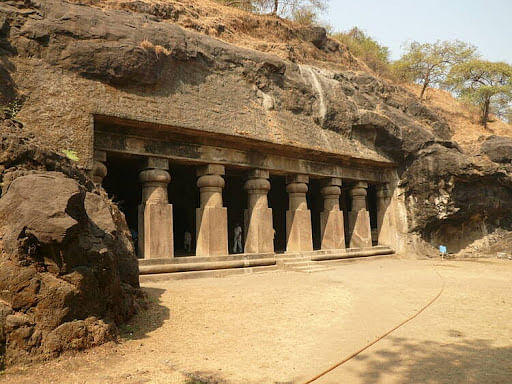

 Indian Olympic Medal Winners List Till N...
Indian Olympic Medal Winners List Till N...
 Who is the Inventor of the Gramophone?
Who is the Inventor of the Gramophone?
 HS Dhaliwal Appointed New DGP Of Andaman...
HS Dhaliwal Appointed New DGP Of Andaman...
